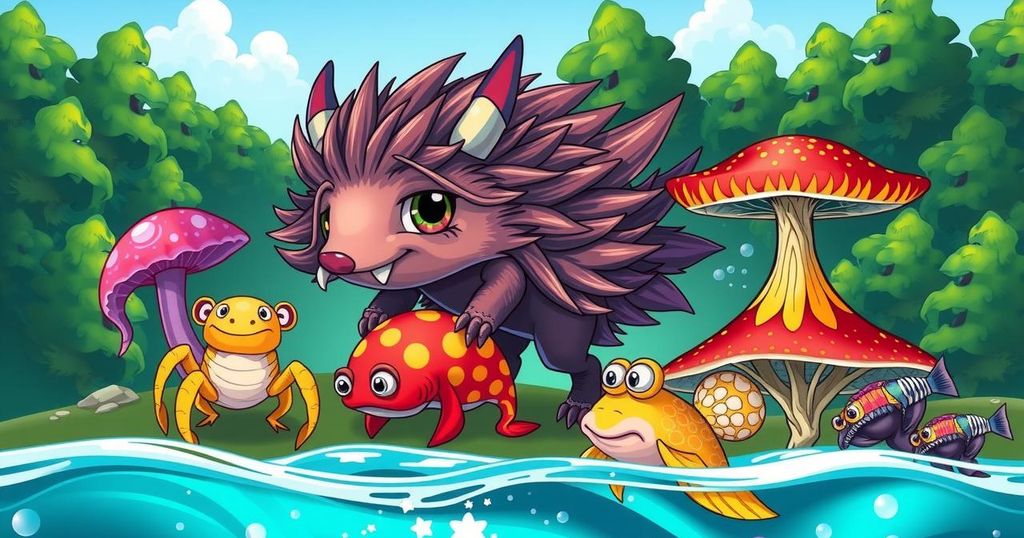Scientists discovered thousands of unique species in 2024, including bizarre new finds like vampire hedgehogs and fishy fungi, highlighting the planet’s biodiversity amid ongoing threats from human activities. Experts warn about the extinction crisis while celebrating the treasures uncovered across various ecosystems.
In 2024, scientists have made an incredible number of discoveries, unveiling some bizarre new species from around the globe. From the depths of ocean trenches to secluded mountain habitats, researchers have documented thousands of previously unrecognized flora and fauna. As we face unprecedented ecological challenges, these findings remind us of the rich biodiversity that still exists on Earth, a stark contrast to the troubling rates of extinction driven by human activity.
Despite a grim backdrop of extinction proceeding at alarming rates—estimated at 100-1,000 times faster than nature would typically dictate—biologists have still cataloged a colorful spectrum of life, adding to the already immense collection of 2.2 million known species. The California Academy of Sciences contributed significantly, identifying 138 new entries, including endangered edible dahlias, ghost sharks, and several species of sea slugs. Meanwhile, London’s Natural History Museum added a staggering 190 new life forms, including new piranha and dinosaur species discovered in Scotland.
Geneticists have also been busy. They revealed that two populations of killer whales in the North Pacific are distinct species. Off the coast of Costa Rica, researchers from the Schmidt Ocean Institute discovered four new species of deep-sea octopuses, along with over a hundred varieties of marine life from the Nazca Ridge. Within these numerous discoveries, several standout peculiarities caught the attention of scientists and enthusiasts alike.
One strange find is a new type of fungi, known for its fishy smell, identified by the Royal Botanic Gardens in Kew, London. This year, about 149 new plants and 23 fungi were documented. Among those, three fungi emit a distinct odor reminiscent of seafood, courtesy of trimethylamine compounds released when handled. For instance, one species, Russula lapponica, was unearthed in the forests of Northern Europe, while Russula neopascua was discovered in Colorado’s Rockies.
Then there’s the vampire hedgehog, a whimsical name for a recently discovered species with surprisingly long fang-like teeth. Found in Vietnam, it measures about five inches and is furry rather than spiny. Though first photographed in 2009, it wasn’t until researchers dived into museum archives and performed genetic analysis that they recognized it as a novel species. The purpose of its large fangs is still under investigation, though they might play a role in mating rituals.
A plant called wi mukoup, or ghost palm, stands out too. Researchers in Borneo identified this rattan palm thanks to its ghostly white undersides and spooky name. This newly recognized species will hopefully contribute to conservation efforts in its native habitat.
Over in the Pacific, a stretch of seafloor called the Bounty Trough yielded over 100 new species during a three-week expedition. Discoveries included dozens of mollusks and a mysterious coral-like creature initially mistaken for a sea star. And in Vietnam, the Cao Bang Crocodile newt was found, known for its bumpy, dark appearance and bright orange toes, highlighting the ongoing plight facing the world’s amphibians due to habitat loss and poaching.
Adding to the list of oddities, researchers found two pirate spider species. Located in St Helena’s cloud forest, they aggressively take over the webs of other spiders, leading to them being nicknamed after their piratical behavior. And let’s not forget Kermitops gratus, a fossilized skull resembling a bony salamander, even though it may have been given an overly childlike name based on its resemblance to the famous puppet frog.
Despite these fascinating finds, the tone remains sobering. Martin Cheek from the Royal Botanic Gardens warns about the dire situation of biodiversity loss as new species often teeter on the brink of extinction. “New species are being found on the edge of extinction,” he remarked, highlighting the urgent need for conservation. As 2025 approaches, it’s crucial that we pay attention to these discoveries and support global efforts to protect them.
As 2024 showcases a plethora of extraordinary new species, it also serves as a reminder of the challenges facing global biodiversity. The discoveries, ranging from vampire hedgehogs to fishy fungi, highlight the continuing exploration of Earth’s hidden treasures, yet underscore a significant ecological warning. Addressing the crisis in biodiversity is paramount, as unchecked human actions threaten these newly uncovered life forms before they can be fully understood. The urgency for conservation has never been more critical, shaping not only the future of these species but the health of our planet.
Original Source: www.bbc.com






